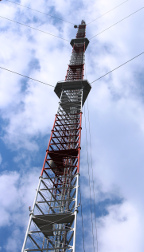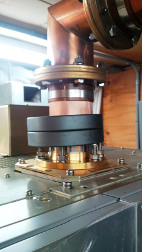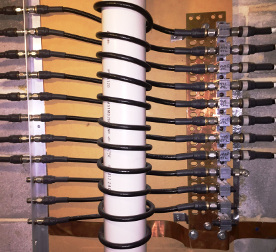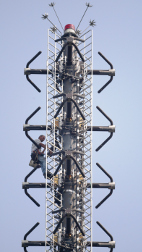Protecting Your Facility From Lightning Strikes – Part Two

A tall tower is a very good invitation for lightning strikes. (PHOTO CREDIT: James E. O’Neal)
ALEXANDRIA, VA.—In the first installment of this series, we focused on broadcasting facility problems caused by AC power line surges or spikes and learned that some 92 percent of these damaging transients were manmade in origin. However, just because storm-induced glitches are statistically less likely, this doesn’t mean that they can be ignored.
“The broadcast industry, in general, operates with some of the tallest man-made structures on earth,” said Kevin Turner, an AC power specialist with Smiths Power. “These are prone to lighting strikes, and the associated facilities involve networks that have to be highly reliable. People rely on the broadcasting industry for critical safety information and these networks really can’t be allowed to go down.”
Broadcast transmitting towers are ideal targets for lightning strikes, with some being struck on a regular basis.
“Broadcasters get it from both ends,” said Roz Clark, director of technical operations for a number of Cox Media Group broadcast properties located in Florida—a state known for frequent thunderstorm activity and its low open terrain. “They have to deal with power line strikes and also lighting hits at transmitter sites. A tall tower stands out like a sore thumb.”
So what can a broadcaster do to protect his or her very expensive equipment from nature’s electrical wraith?
SURGE PROTECTORS CAN WORK WONDERS
The professional video industry's #1 source for news, trends and product and tech information. Sign up below.
A good place to start is with the installation of surge protection devices. Jeff Welton, Nautel’s regional sales manager for the central United States and former customer support technician,highly recommends the use of MOV “shunt-type” protectors at all transmitter sites.
“You want to place the MOVs close to your ground point,” said Welton. “If you get a surge on your tower, it couples through your transmission line coax and hits the point where this is grounded at its entrance to the building. That ground potential spikes high—up to multiple thousands of volts.If you have a bi-directional MOV surge protector going back to your AC entrance (connected with the shortest, heaviest gauge wires possible for least inductance), and connect to that ground point with a low inductance ground strap, the MOV will decouple the spike to the AC line, and power companies graciously provide thousands of miles of lines to dissipate the surge. A MOV-type surge protector is not just an AC power line protection device. It can protect you in both directions if you’ve got good low inductance feeds to it.”
THOSE WONDERFUL ‘DOUGHNUTS’

A very simple and easy way to soften the blow from a lightning strike to your antenna or tower is to install large ferrite “rings” [toroids] over the transmission line close to the transmitter output flange. (PHOTO CREDIT: Nautel)
Another very good defense against lightning problems are ferrite toroids—just like the ferrite beads sometimes used on equipment power cords, but much bigger.
“Install ferrite toroids on the coax between that ground point and the transmitter. The toroids reject common mode surges,” said Welton. “If you get a surge on the center conductor—which isn’t very likely—or on the shield when there’s a tower strike the ferrite will saturate and attempt to induce an equal surge on the opposite conductor so the potential stays the same. This is because of the magnetic field of the ferrite.”
Welton noted that Nautel ships ferrite toroids with every transmitter the company sells. He also wanted to inform readers about a lightning protection white paper available on Nautel’s website. While it was written for radio station operators, it provides many useful pointers for television plants too. It’s available here.
HOMESPUN LIGHTNING REMEDY
Cox Media Group’s Roz Clark offered another transmitter site lightning protection tip that readers might want to adopt for smaller diameter coax cables entering the building, such as those from STLs, two-way radio antennas and the like.
“This is nothing that you can buy off the shelf, but it is fairly easy to construct” said Clark. “We simply form the coax cables into loops [around a piece of large diameter PVC tubing] to create a high impedance path to a strike. We’ve found that this offers a good degree of protection.”

This homebrew “wrap” methodology may help ward off lightning damage to gear connected with smaller coax cables. (PHOTO CREDIT: Roz Clark)
ELIMINATE LIGHTNING BEFORE IT CAN STRIKE!
Paul Shulins, director of technical operations for Greater Media Boston, also sees value in the installation of lightning “dissipation” devices, also known as lightning spurs, static dissipators, streamer-delaying air terminals and a host of other names. These are metallic devices constructed with a large numbers of “points” or “fingers”. They tend to reduce the electrical voltage between a storm cell and the antenna or tower by transferring charge to nearby ionizing air molecules. This controlled charge leakage reduces the chance of a lighting strike to a tower or antenna. The desired effect is to prevent a lightning strike to the structure, but even if the accumulation rate exceeds the dissipation rate, the devices will divert the strike away from equipment toward a safer path to ground,one that’s defined by the original ground system.
“In my experience, lightning dissipation devices seem to work well,” said Shulins. “They’re installed on the master radio and TV antenna at the Prudential Building here in Boston and it’s never sustained any lightning damage over the past 25 years or so.”
He noted that no technology is perfect, and damaging strikes do happen from time to time; however, the dissipation devices, along with other protective measures, seem to greatly decrease potential for damage.
‘BE PREPARED’

The flower-like devices atop this tower are not there for decoration! They are known as “dissipators” and can help reduce the severity of lightning strikes, or in some cases ward them off completely. (PHOTO CREDIT: Paul Shulins)
It seems as if the television engineering community is busier than ever due to the constantly changing technology updates; however, you really need to make time to give careful study to your transmission facility to see if it’s adequately protected from the ravages of atmospheric electricity.
Greg Best, a Kansas City, Mo.-based telecommunications consultant and owner of the Greg Best Consulting firm, stressed that good grounding practices are absolutely essential in keeping a transmitter plant safe.
“If you don’t have a good ground system, you’re living on borrowed time,” said Best. “You’re really asking ‘which piece of equipment do you want to replace next?’ Also, just because you’re next door to someone with a 1,000-foot tower and you only have a 200-footer, don’t feel too secure. You never know what lightning is going to do.”
Lightning won’t wait for a convenient time to strike. It could be as near as the next thunderstorm. The Boy Scouts said it best—“Be Prepared!”
(This is the second installment of a multi-part article; the next installment will examine grounding and bonding practices.)
James E. O’Neal is a retired broadcast engineer with more than 35 years of experience in the field. For the past 10 years he has served as technology editor at TV Technology magazine.
